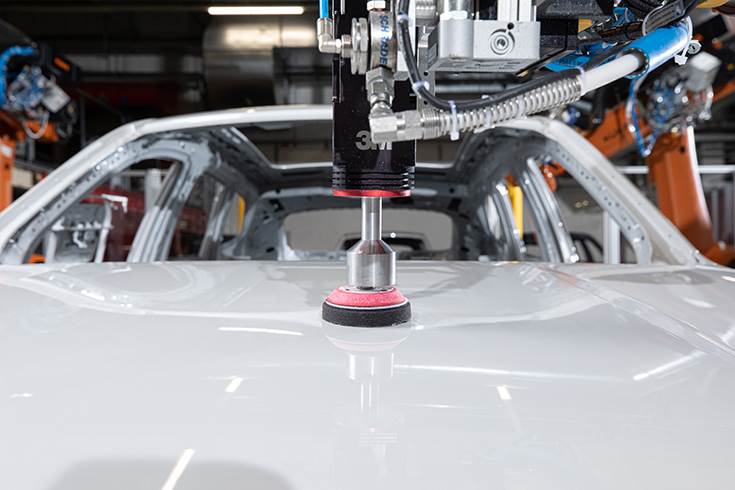BMW Group Plant Regensburg has become the automotive industry’s first plant worldwide to use an end-to-end digitalised and automated process for inspection, processing and marking of painted vehicle surfaces in standard production.
In an innovative new approach, AI-controlled robots process each vehicle individually to meet objective quality standards. This ensures more stable operations, shorter lead times and a consistently high level of vehicle surface quality. Data stored in the cloud also enables optimal analysis of causalities and therefore represents another step by the BMW Group towards the digital and intelligent connected factory referred to as BMW iFactory.
 Painting, sanding, polishing with AI
Painting, sanding, polishing with AI
The scene resembles a well-rehearsed play: Four robots stand in the processing booth, surrounding a freshly painted vehicle body. As if on command, the robots begin working on the surface of the body. They sand it, apply the polishing compound, polish, change the attachments and switch out the sandpaper. Cameras track the scenario.
“What is unique here is that the robots work on each body exactly where needed – because the tiny specks and bumps that can appear after the topcoat is applied and that we want to remove are in different spots on each vehicle,” explains Stefan Auflitsch, head of Production Paint Application and Finish at BMW Group Plant Regensburg. “Robots are normally programmed to follow the same pattern until they are reprogrammed. Using artificial intelligence allows them to work in a more tailored manner. With up to 1,000 vehicles going through the finishing process every working day, that adds up to 1,000 unique processes.”

Automated Surface Processing has been used in series production at BMW Group Plant Regensburg since March 2022. The plant is the first car plant worldwide to use the AI-based process on this scale. To ensure everything runs smoothly, this step is preceded by another automated process that has been considered state of the art in the automotive industry for some time: The Automated Surface Inspection begins by identifying and recording the features that require processing after the topcoat has been applied.
In the Automated Surface Inspection, the system first uses deflectometry to identify deviating characteristics. While large monitors project black and white striped patterns onto the vehicle’s surface, cameras scan it and detect even the slightest variation in the reflective paintwork through the change in the striped pattern. Like a perfectly trained eye, the camera registers areas that deviate from the ideal and transmits this data directly to the connected computer system. The computer saves the exact position, shape and size of the deviations, creates a digital 3D image from the data and classifies it, based on objective criteria. In this way, all vehicle surfaces are inspected for customer quality assurance purposes and treated as needed.
“The system already knows as much today as our best employees combined. We used the knowledge of our entire team to finalise the system; the functioning of the equipment relies on our associates’ unique expertise. We channelled their experience into the programming – on this basis, the algorithm now recognises and objectively decides which features need post-processing,” explains project manager Daniel Poggensee, a structural planner for Surface Technology. From the data collected, the system creates a separate profile for each body that then serves as the basis for custom surface processing. This means no bump, no matter how small, can escape detection.
The new method offers even more advantages than just reliable detection of characteristics and a shorter process lead time: Automated Surface Processing not only processes all deviations recorded in the optimal order, and with the appropriate speed, but also with stability, repeatability and always with the same premium quality.
 Step by step to the connected factory
Step by step to the connected factory
However, there are limits to the use of robots. For example, they cannot process the edges of the body or the final millimetres next to the door and other joints. The fuel filler flap is also too fragile. For this reason, it is ultimately trained employees who add the finishing touches and conduct the final inspection of the body. Here, the previously recorded data with the characteristics once again supports their work: A laser projector digitally marks the relevant areas of the body surface to ensure nothing is overlooked.
Automated Surface Marking is therefore the final step so far in the automated finishing process. However, according to Poggensee, there are more ideas for the future: “On the one hand, thanks to the data in the cloud, we expect to soon be able to intervene in the process even earlier if there are any inconsistencies – which will enable us to prevent faults from occurring in the first place.” On the other, the equipment used should be able to automatically record operations performed by employees – so they do not have to go back and forth between the body and the computer for documentation. In addition to saving time, this also reduces complexity and increases the added value.
BMW Group Plant Regensburg is the first plant to use this three-stage automated process in standard production. It is also currently being rolled out to other plants.
